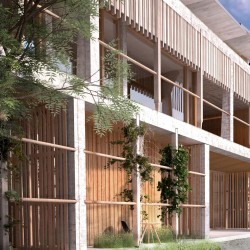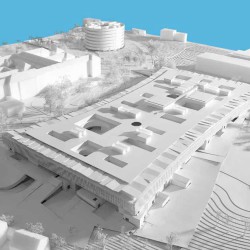The University Children’s Hospital has been operated by the Eleonoren Foundation since 1874. An international competition launched in 2011 called for a new facility in combination with pioneering hospital architecture. The call for proposals specified the client’s requirements as follows: “We wish to create an atmosphere in which children of all ages and their parents will feel as sheltered and comfortable as possible despite their personal circumstances, and a facility that is architecturally and functionally designed to optimize treatment procedures and the work of the staff.” Herzog & de Meuron won the two-phase competition in 2012.
_
The Institution of the Children’s Hospital in Zurich
The mandate of the Children’s Hospital is to supply highly specialized care of children in conjunction with research, teaching, and the fostering of a new generation of academics in the field of child healthcare. The 200-bed hospital is the largest in Switzerland for both inpatient and outpatient care of children and adolescents. The new project in Zürich-Lengg will replace the facility in the Hottinger quarter, which has long outgrown its current capacity.
The Healthcare Campus in Lengg
The site in Zurich-Lengg lies on the outskirts of the city in a leafy residential district, which is also an important recreational neighborhood for residents of Zurich. Geologically, Burghölzli, as the hill is called, is a protected glacial landscape. Two plots of land on a proverbially green meadow have been earmarked for the new project, which is to be integrated in a campus of institutions devoted to various aspects of healthcare. A close neighbor is the Psychiatric University Clinic (PUK), also known as “Burghölzli,” housed in a listed building of 1869 designed by Johann Caspar Wolff.
_
The New Children’s Hospital
The project for the Children’s Hospital in Zürich consists of two buildings: the hospital and a research center. The hospital, on the site to the south, is a distinctly horizontal, three-story structure opposite the “Burghölzli”. The main entrance, a large gate, is exactly opposite the portal of the historical building. The concave gesture of the main façade creates a spacious forecourt for both institutions.
A holistic concept underlies the project, unlike the conventional layout of hospital buildings. These tend to consist of various, often relatively high tracts, which may give patients the impression that they are being shifted back and forth between departments that are separate and distinct and do not work together. The large horizontal shape of the hospital defines the holistic nature of the building, characterized from inside out by a delicacy of material detail.
The words ‘horizontal’ and ‘holistic’ describe the two basic principles, devised by Herzog & de Meuron to meet the requirements of a hospital architecture that responds specifically to the needs of patients and staff. These principles already played a decisive role in 2002 for the REHAB Basel, a special clinic for neuro-rehabilitation and paraplegiology, and apply to another healthcare project underway in Hillerød, Denmark: the New North Zealand Hospital.
The Children’s Hospital follows an urban grid with streets, intersections, and squares. The functions or departments correspond to neighborhoods. Every floor has a main street. Several green inner courtyards varying in size provide daylight and structure the right-angled layout of the rooms. Nature penetrates deep into the building. Some of the courtyards, round in shape, are arranged along the main street where there is access to the most important areas of the hospital.
The ground floor with its large round entry is the most public zone within the hospital. It accommodates the main facilities for examination and treatment with the highest visitor and patient frequency as well as emergency room, intensive care, and operating rooms. Restaurant and access to therapy services on the first lower level are located right next to the entrance; the latter are connected directly to the garden for patients. On the second floor, both sides of the main street are flanked by further divisions of the polyclinic, which are in turn surrounded by an office landscape oriented towards the outside, with some 600 workplaces for medical and administrative personnel.
The top floor is the most private area of the hospital. Four wards form quadrants in which a total of 114 rooms are arranged in a ring structure oriented towards the outside. Each of the rooms is designed like a little house with its own roof, ensuring privacy for the young patients and their relatives in combination with an expansive view. Inside, four therapeutic divisions—cardiology, oncology, nephrology, and the center for brain injuries—are located along the main street, where children and adolescents can receive transdisciplinary treatment and care in the immediate vicinity of their own rooms. The divisions correspond to the special areas addressed in the research center nearby.
The façade of the hospital is a weave of various materials. The primary, repetitive concrete framework is part of the support structure and resembles shelves usable at both ends that bracket the first and second floors. The framework may be filled in with wood, glass, fabric, or plants to meet the needs of the rooms behind it, such as simultaneous requirements of daylight and privacy. The complex inner life of the hospital with its diversity of uses can thus be perceived from the outside. The third floor, with patient accommodations, speaks a language of its own. It is set back from the concrete structure of the two floors below. Each of the rooms can be identified for they are staggered in arrangement with roofs of varying inclines: the little houses lend expression in an elementary, understandable way to the individuality of each patient.
_
Building for Teaching and Research
The building is located on the parcel to the north. It is a cylindrical, white structure in which rooms for university hospital uses are organized around a center as a leitmotif for collaboration. A sky-oriented, five-story high atrium provides a central space for researchers. An agora for teaching spreads out underneath, relating directly to the surrounding landscape. The two superimposed main spaces of the building are like communicating vessels, connected by a small, round opening in the ceiling – an oculus.
Three lecture halls are pressed like steps into the hollow of the existing topography. Daylight comes in from outside. Fitted with operable partitions, the halls can be converted into a large space with lobby and café. For special events, an agora can thus be created for an audience of 670 people, like an ancient theater with a stage in the center. This is expanded above into a gallery, with desks for students. Adjoining seminar rooms on the same floor complete the accommodations for university study at the Children’s Hospital. Research and diagnostic laboratories as well as attendant offices with permanent workplaces are organized along the façades of the upper five stories. They offer an unobstructed view of the surrounding landscape. Open writing desks for doctoral students and laboratory staff line the atrium and provide visual lines of contact across several stories.
From the outside, the building speaks an abstract formal idiom with a clear-cut geometry and few materials. Cantilevered balconies with white stucco railings and glazing set far back make the building look both heavy and airy at once.
The two very different buildings of the Children’s Hospital are mutually complementary. The hospital emphasizes the individual: every single patient and the attendant healing process. The Building for Laboratory, Teaching, and Research clearly demonstrates the conviction that pioneering breakthroughs in research are possible only through transdisciplinary scientific cooperation.
Herzog & de Meuron, 2022






















